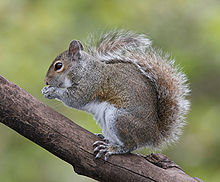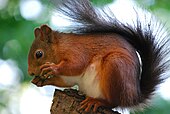
An invasive species is an introduced species to an environment that becomes overpopulated and harms its new environment. Invasive species adversely affect habitats and bioregions, causing ecological, environmental, and/or economic damage. The term can also be used for native species that become harmful to their native environment after human alterations to its food web. Since the 20th century, invasive species have become a serious economic, social, and environmental threat worldwide.
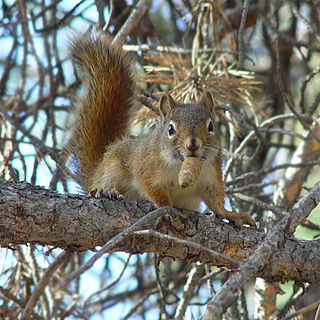
Pine squirrels are squirrels of the genus Tamiasciurus, in the Sciurini tribe, of the large family Sciuridae.
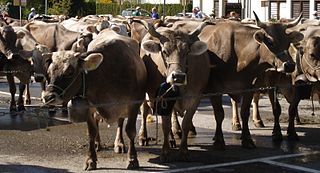
An introduced species, alien species, exotic species, adventive species, immigrant species, foreign species, non-indigenous species, or non-native species is a species living outside its native distributional range, but which has arrived there by human activity, directly or indirectly, and either deliberately or accidentally. Non-native species can have various effects on the local ecosystem. Introduced species that become established and spread beyond the place of introduction are considered naturalized. The process of human-caused introduction is distinguished from biological colonization, in which species spread to new areas through "natural" (non-human) means such as storms and rafting. The Latin expression neobiota captures the characteristic that these species are new biota to their environment in terms of established biological network relationships. Neobiota can further be divided into neozoa and neophyta (plants).

The eastern gray squirrel, also known, particularly outside of North America, as simply the grey squirrel, is a tree squirrel in the genus Sciurus. It is native to eastern North America, where it is the most prodigious and ecologically essential natural forest regenerator. Widely introduced to certain places around the world, the eastern gray squirrel in Europe, in particular, is regarded as an invasive species.

The western gray squirrel is a tree squirrel found along the western coast of the United States and Mexico. In some places, this species has also been known as the silver-gray squirrel, the California gray squirrel, the Oregon gray squirrel, the Columbian gray squirrel and the banner-tail. There are three geographical subspecies: Sciurus griseus griseus ; S. g. nigripes ; and S. g. anthonyi.

The red squirrel or Eurasian red squirrel is a species of tree squirrel in the genus Sciurus common throughout Europe and Asia. The red squirrel is an arboreal, primarily herbivorous rodent.

Pinus pinaster, the maritime pine or cluster pine, is a pine native to the south Atlantic Europe region and parts of the western Mediterranean. It is a hard, fast growing pine bearing small seeds with large wings.
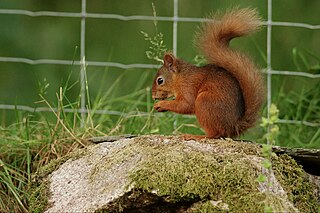
Squirrelpox virus (SQPV) is a virus that causes the fatal disease squirrelpox in United Kingdom and Republic of Ireland red squirrels. The virus is often carried by grey squirrels from North America, which rarely die from the disease. Elsewhere in the Red Squirrel's European range, either the grey squirrel does not occur or it lacks the poxvirus.

The fox squirrel, also known as the eastern fox squirrel or Bryant's fox squirrel, is the largest species of tree squirrel native to North America. Despite the differences in size and coloration, it is sometimes mistaken for American red squirrels or eastern gray squirrels in areas where the species co-exist.

Black squirrels are a melanistic subgroup of squirrels with black coloration on their fur. The phenomenon occurs with several species of squirrels, although it is most frequent with the eastern gray squirrel and the fox squirrel. Black morphs of the eastern gray and fox squirrels are the result of a variant pigment gene. Several theories have surfaced as to why the black morph occurs, with some suggesting that the black morph is a selective advantage for squirrels inhabiting the northern ranges of the species, with the black fur providing a thermal advantage over its non-melanistic counterpart.
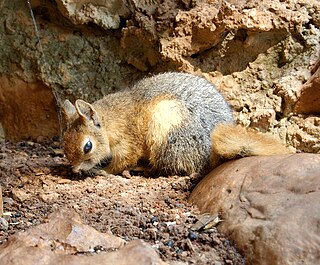
The Caucasian squirrel or Persian squirrel, is a tree squirrel in the genus Sciurus found in temperate broadleaf and mixed forests in south-western Asia.

The red-tailed squirrel is a species of tree squirrel distributed from southern Central America to northern South America.

The Japanese squirrel is a tree squirrel in the genus Sciurus endemic to Japan. It was described by Dutch zoologist Coenraad Jacob Temminck in 1844. The Japanese squirrel's native range includes large portions of the islands of Honshū, Shikoku, and Kyūshū. The Japanese squirrel is absent from Hokkaido, where it is replaced by the related red squirrel, which is conversely absent from the rest of the Japanese archipelago outside Hokkaido. Recently, populations in south-western Honshū and Shikoku decreased, and those on Kyūshū disappeared. One of the factors affecting the recent local extirpations of this species seems to be forest fragmentation by humans.

Islands, such as the British Isles, can be adversely affected by the introduction of non-native species. Often an island will have several distinct species not present on the nearest mainland, and vice versa. The native flora and fauna of islands which have been isolated for a longer period of time such as New Zealand or Hawaii are more vulnerable than islands such as Great Britain and Ireland, which became isolated more recently.
As with a number of other geographically isolated islands, Hawaii has problems with invasive species negatively affecting the natural biodiversity of the islands.

John L. Koprowski, Dean and Professor, Haub School of Environment & Natural Resources, University of Wyoming, mammalogist, conservation biologist, and leading expert on the ecology and conservation of wildlife, especially squirrels, was born in 1961 in Lakewood, Ohio.

Pallas's squirrel, also known as the red-bellied tree squirrel, is a species of squirrel native to China, Taiwan, India, and Southeast Asia.

The Calabrian black squirrel is a species of tree squirrel in the genus Sciurus, endemic to the forests of the regions of Calabria and Basilicata, in the south of the Italian Peninsula.
